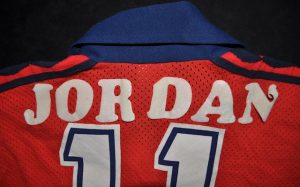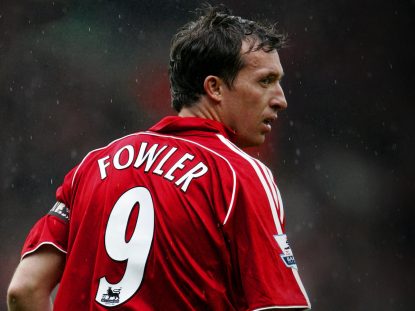- Our friend Simon Shakeshaft wrote this piece for the current edition of Programme Monthly and has kindly shared it with us.
To everybody going, there was nothing unusual about Scotland entertaining Peru at Hampden Park for an international friendly in September 1979.
Billed by the Scottish FA “as not a grudge match or about revenge” after the embarrassing defeat suffered at the previous year’s World Cup finals in Argentina, it was only after the anthems and the Scotland team removed their tracksuit tops to expose their shirts, that the best-kept secret of the time was revealed. Only a handful of people linked to the SFA and kit manufacturers Umbro knew of secretary Ernie Walker’s plan to ‘Americanise’ Scotland’s match shirts, which were emblazoned with individual players’ names. In doing so, Scotland became the first international team ever to wear names on the backs of their shirts.
The late Walker, who had come up with the idea after visiting the USA and watching NASL games the previous summer, stated in his programme notes for the next home game, against Austria, “they will be commonplace in the future” and that in 20 years’ time, “as likely as not, club sides will probably have followed suit”. This was amazing foresight but unfortunately for the pioneers Walker and the Scottish FA, they weren’t to be rewarded with the huge revenue streams names on shirts realise for clubs and national associations today.
The idea, described as “to improve communication between the field of play and the spectators” – incidentally Herbert Chapman said something similar when trying to introduce numbers to shirts in the late 1920s and as the great Arsenal manager experienced, such innovations are not without teething problems.
***
Two types of letter fonts were used on three different shirt styles, with kit manufacturers Umbro’s larger capitalized letter font most commonly applied. Because the SFA were initially unsure they would be allowed to be use the names in competitive qualifying matches, a standard retail shop smaller letter, first seen in Euro qualifier against Portugal in March 1980, was also used.
The difference can be seen on the two shirts pictured, Kenny Burns’ number 6 shirt from that first game against Peru – with old-style cloth numbers – and another Burns shirt, number 4, worn against Northern Ireland – with new flock outline number font – in March 1981.


The third shirt style that was adorned with players’ names was the red away style and the one that was to caused the most embarrassment.
A Friday night visit to Windsor Park to face Northern Ireland in the Home International opener of the 1980 Championships, saw Scotland decked out in their new red away shirt, an Aertex version, the perforated lightweight material. It was only at short notice that the smaller font letters were used on the shirts and applied not by Umbro but by a Glasgow sports shop, formerly Lumley’s, now known as Greaves Sports.

The disappointment was losing the game 1-0, but the embarrassment occurred when the letters started to peel off the shirts!! They had been applied using the wrong temperature, therefore not adhered fully and once the players sweated and the Aertex material was stretched, the letters just pinged and peeled off. This was made worse when the players found it amusing to completely peel the hanging letters off their teammates jerseys!
A particularly rare shirt, the red away having only been worn with names once, in this fixture, with the Joe Jordan shirt pictured clearly showing the delicate letters just about hanging on.

Match-worn versions of these shirts are real rarities, much sought-after by Scotland and other international shirt collectors. Examples do occasionally appear or are found in the personal collections of former players and have over recent years popped up more regularly for sale at Auction Houses and online auction sites.
A Kenny Dalglish shirt, swapped with Terry McDermott after Scotland v England in 1980, was sold privately in 2008 for over £1,200 and a Graham Souness shirt from the personal collection of former Welsh goalkeeper Dai Davies fetched just over £1,000, including buyer’s premium, in the same year.
The names adorned the Scotland players shirts 13 times over two years but for obvious logistical reasons, only in home fixtures or in matches against the other home nations.
It helped that squad numbers were used for the 1980 and 1981 British Championships, avoiding any last-minute changes for away games at Wembley, the Vetch Field or Windsor Park. They were last seen on the backs on the shirts for the World Cup qualifying fixture against Sweden in September 1981, by the end of that year and the introduction of a new shirt design in February 1982, they were gone.
The reason for abandoning their use isn’t known, but it’s understood kit manufacturers Umbro became frustrated with the situation. Although favorably received, they weren’t “here to stay” as Walker predicted – well, not immediately. It was just over a decade later when names were next seen on Scotland shirts, at Euro 92 in Sweden, and then on every international shirt at every major championship finals since.
So, if as Walker had said, you are on a quiz show and the question is asked, “What was unique about Scotland’s friendly match with Peru in September 1979?” You will know, “the name of the game”, was actually a Scottish first.
- Simon, the curator of the Neville Evans National Football Shirt Collection, is a match-worn shirt collector, now specialising in Hereford United and Wales players shirts. He was co-author of The Arsenal Shirt book, contributed to the They Wore The Shirt, the history of the Wolves shirt, and is currently co-authoring the forthcoming The Spurs Shirt book with Daren Burney and Neville Evans. He can be contacted at simon@thenationalfootballshirtcollection.co.uk.






4 Comments
[…] the other side of the Atlantic, they were a bit more wary of the modernisation but Scotland tested the waters in 1979. One of their eminent clubs, Celtic, gave it a go a year later for Danny McGrain’s […]
[…] shorts numbers were a different font. The players’ names featured on the backs of the shirts, but this wasn’t a first for Scotland. In addition, the newer Umbro logo, with a capped wordmark, appeared on the […]
[…] For the first time, numbers appeared on the front of the shirt while, as at Italia 90, the shorts numbers were a different font. The players’ names featured on the backs of the shirts, but this wasn’t a first for Scotland. […]
I have a Burley shirt with 13 on the rear.
Can you please help me with info?
Alex
[…] footballers in action. As world renowned kit expert Simon ‘Shakey’ Shakeshaft explains here, Scotland were the first national team to try the concept from 1979-1981, inspired by a visit of […]